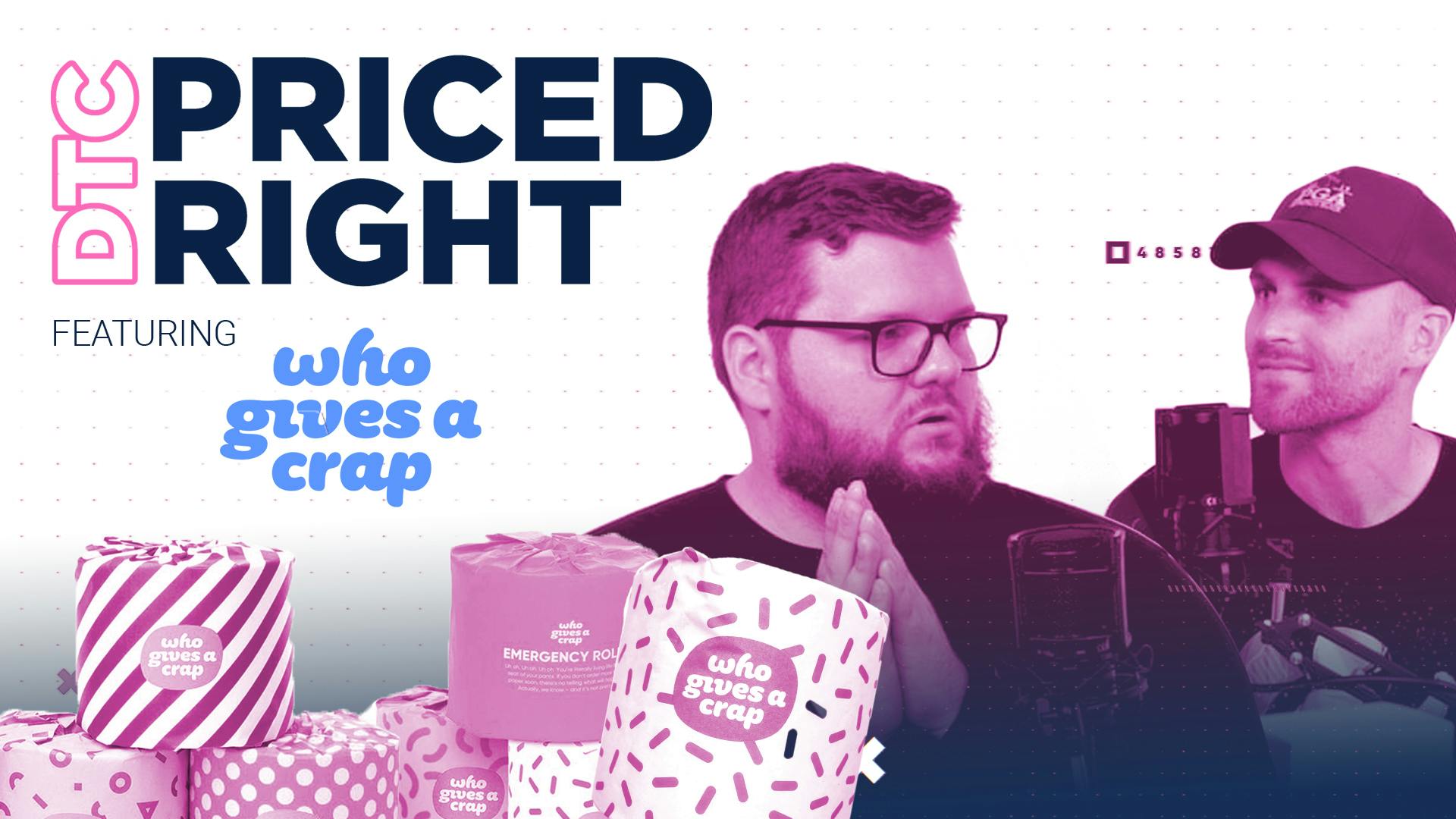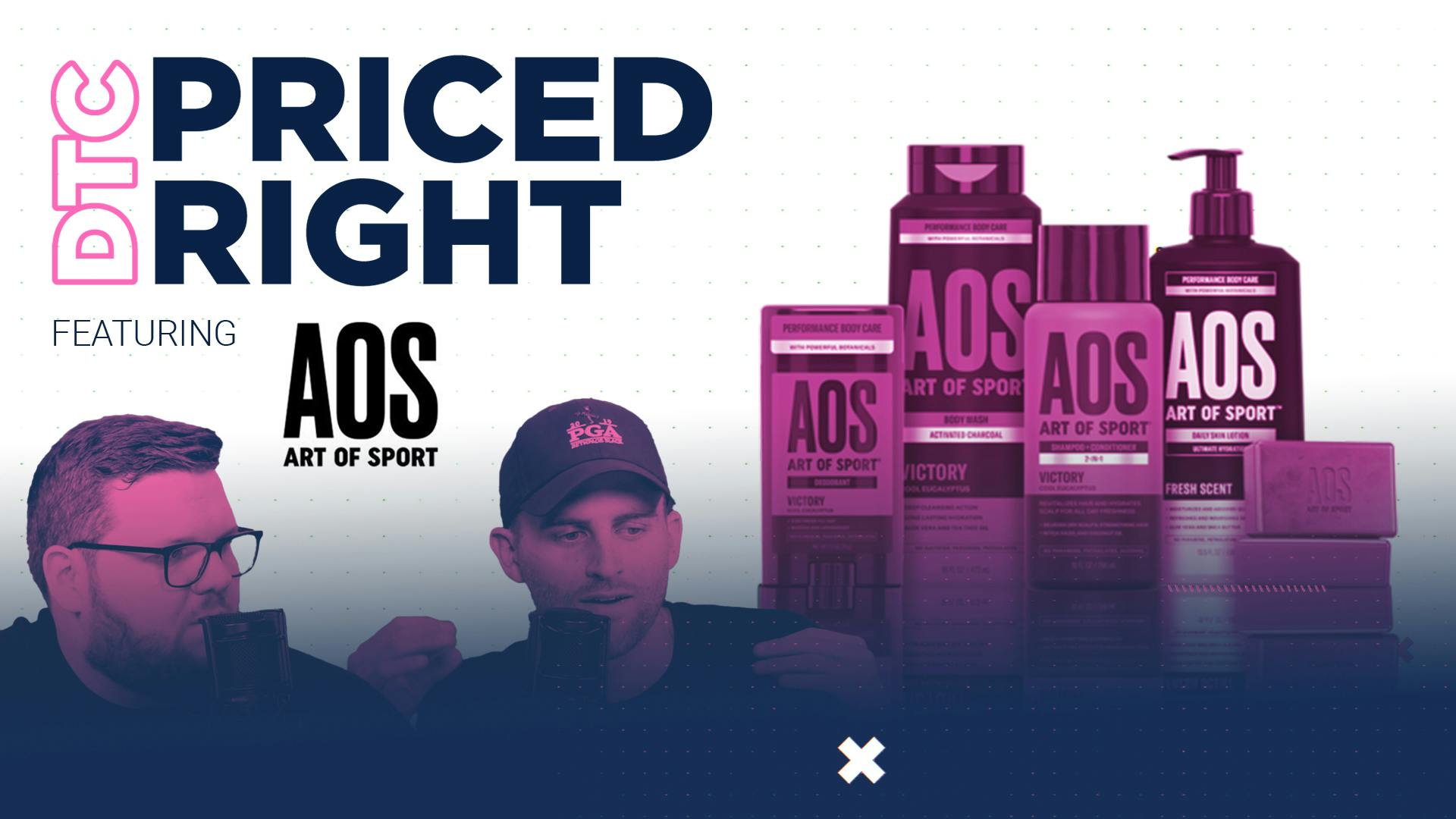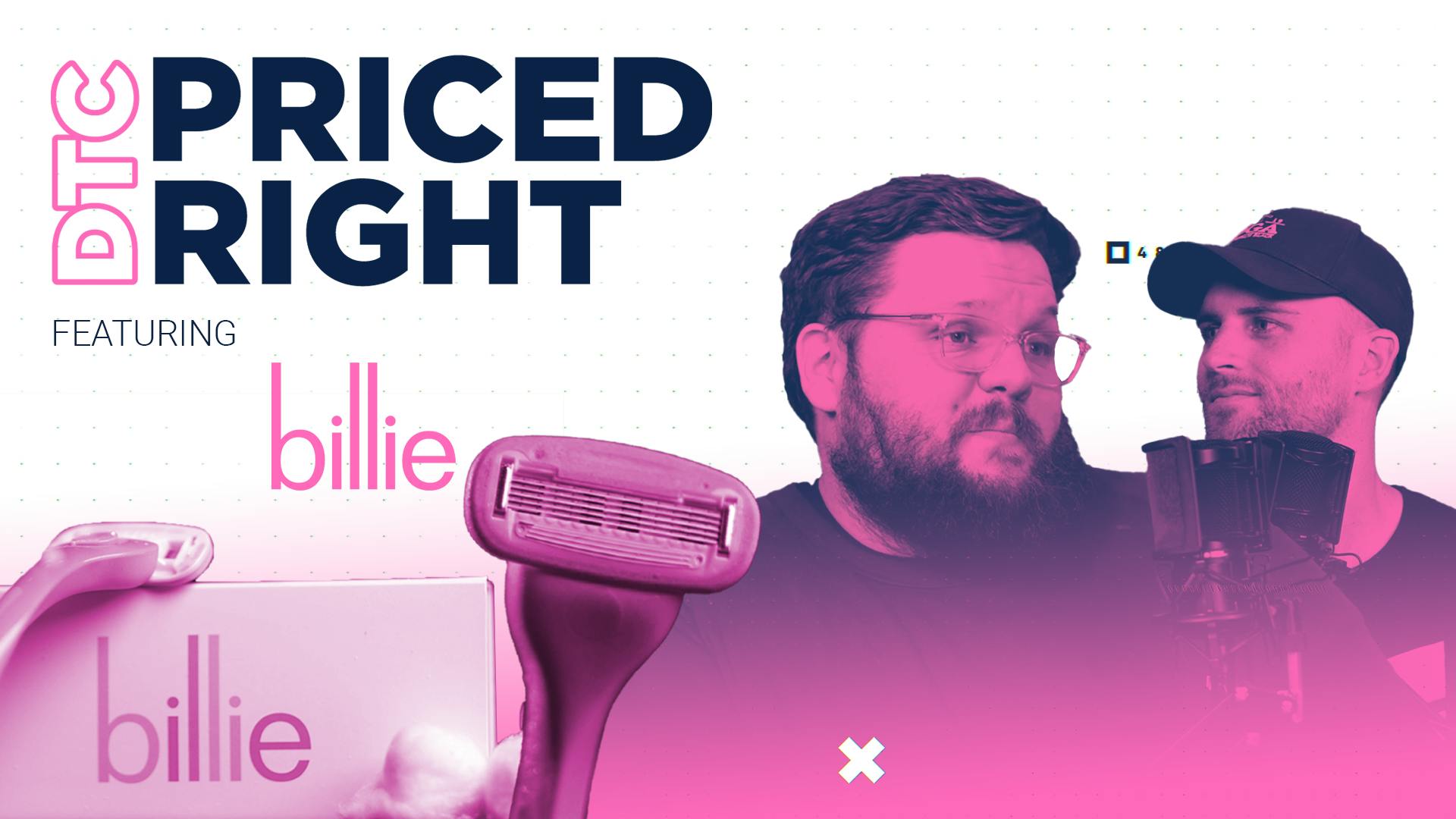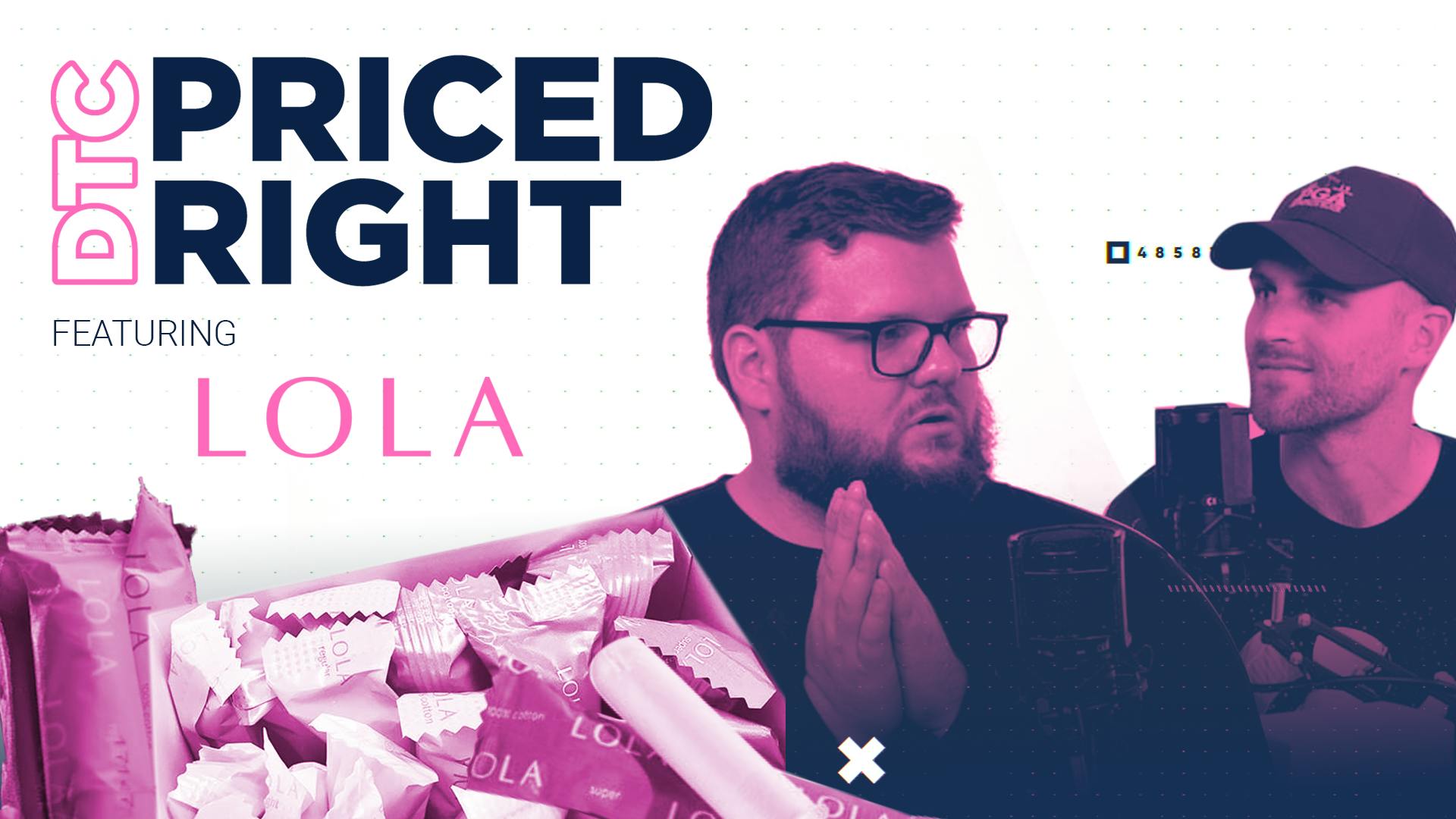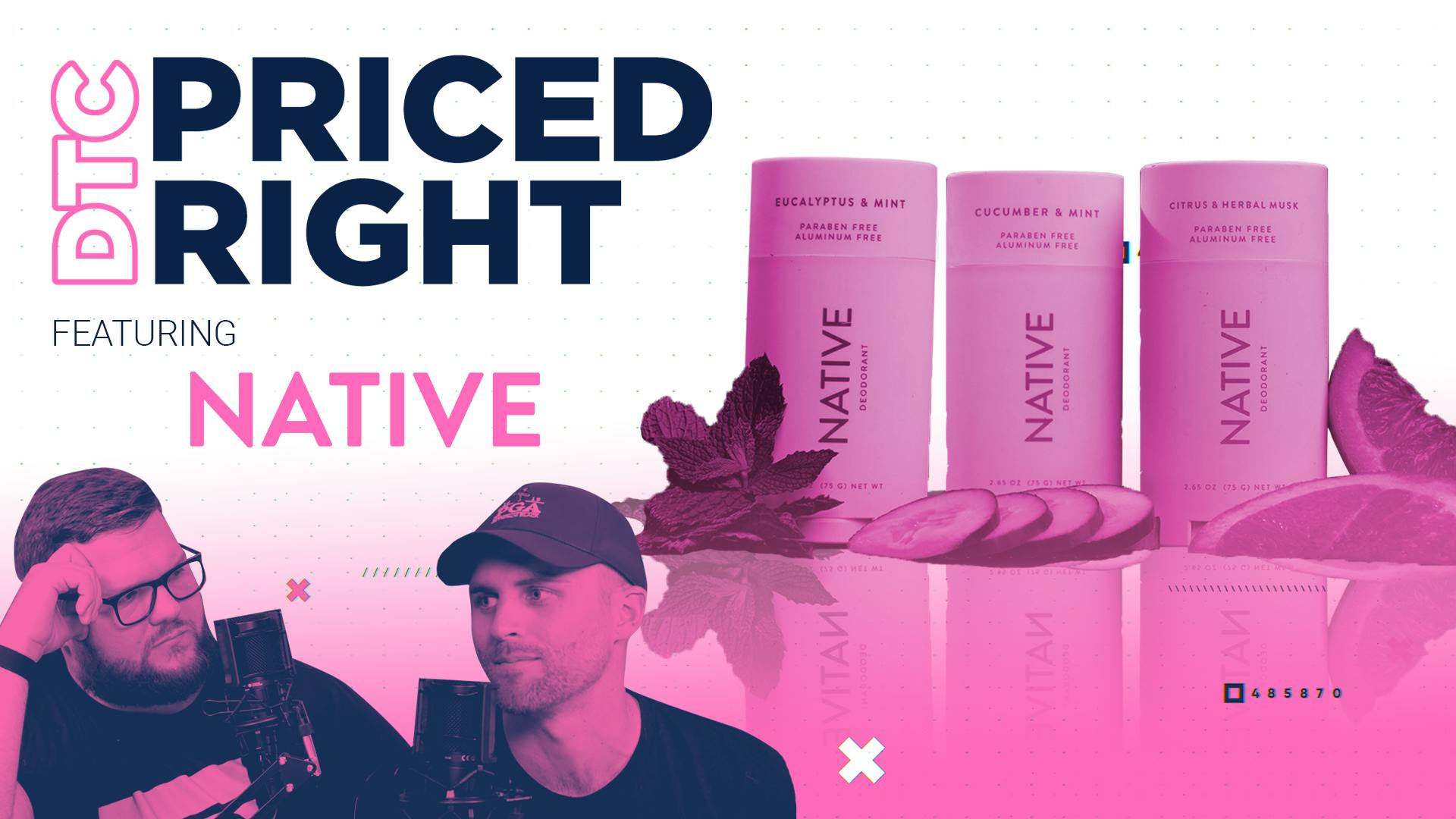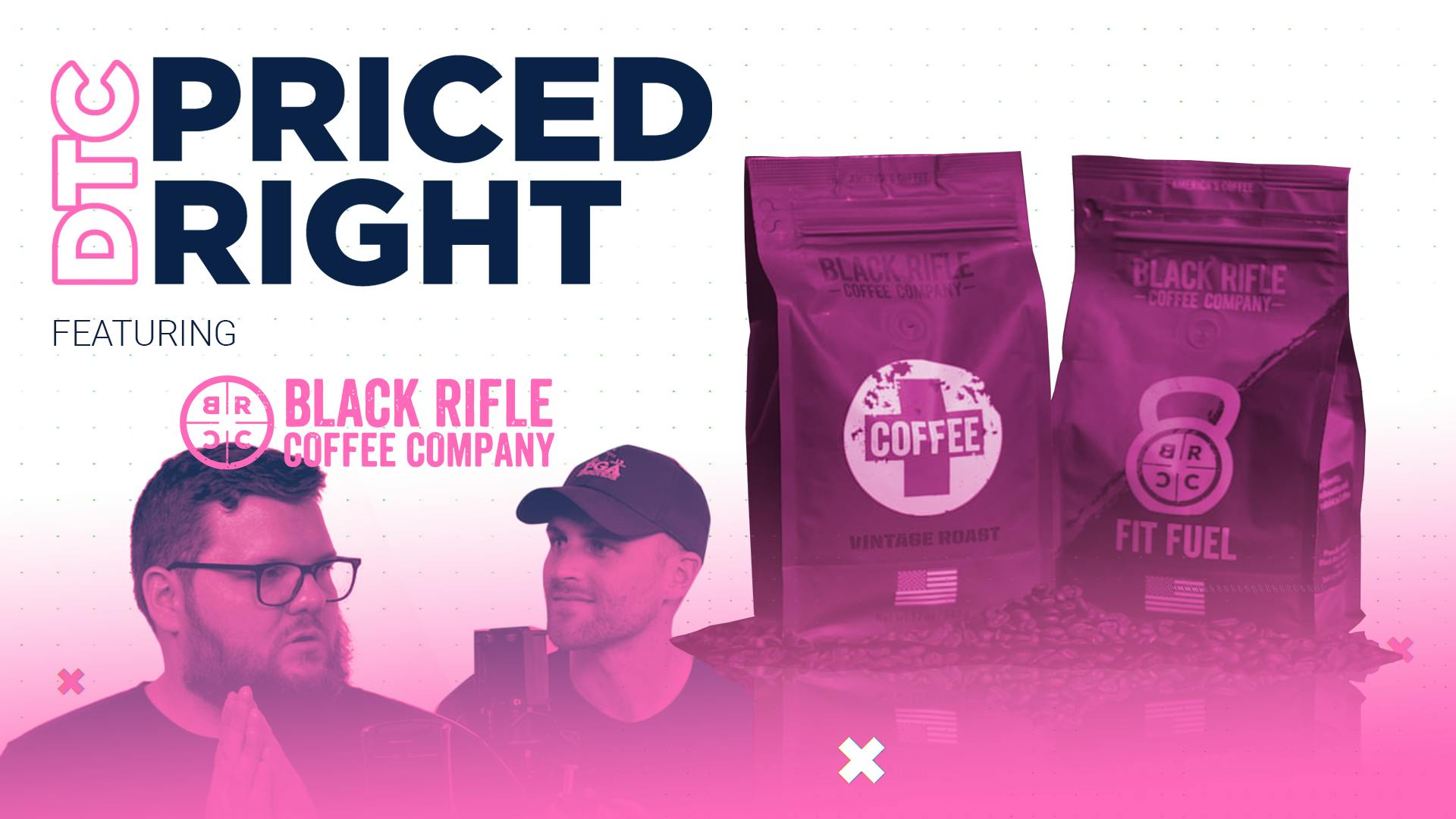
Is Barkbox barking up the right price?
This episode might reference ProfitWell and ProfitWell Recur, which following the acquisition by Paddle is now Paddle Studios. Some information may be out of date.
Please message us at studios@paddle.com if you have any questions or comments!
Fun fact: we've found in our research that the willingness to pay for any dog related product is much higher, almost double, if not 150% higher than what someone is willing to pay for their cat.
This week we're talking about who let the dogs out. We're talking about BarkBox, which we can learn a lot from. But there's also some things that BarkBox could be doing even better when it comes to their monetization. And we'll wrap up all of those learnings into a nice case study, so that everyone who's watching this, and everyone you send this to can start getting their monetization on the right track.
Pricing field notes
BarkBox has over 600,000 subscribers with a 95% retention rate. With its incredibly successful subscription platform, is BarkBox the perfect subscription company? Or are there ways they can improve their strategy even further to drive value?
Below are some valuable takeaways you can use for your own business.
- Offer longer-term plans
Higher percentages of longer-term plans correlate with a lower percentage rate of churn. Customers on longer-term subscriptions have a much longer lifetime and retain at a 15-30% higher rate than monthly subscriptions.
Offer longer-term plans in exchange for a discount. However, offer physical amounts off instead of percentages. Whether it's a free product or a physical dollar amount, this works roughly 2x better than using a percentage off. - Fragmented markets provide opportunities for differentiation
The willingness to pay for fragmented types of users is different. Take advantage of that by unbundling certain features and making sure that they’re add-ons. Customers who have at least one add-on or additional purchase tend to have 18-54% higher lifetime value.
Collect data to compare feature preferences to understand which should be add-ons you can expand into.
Hone in on different use cases with different add-ons and make your product a lot more variable. - Localization is key
Adjust prices to local markets. Our data shows that depending on the market, the willingness to pay can be significantly less than the US, or as much as 85% more.
If you’ve reached the $10 million-dollar mark, localization is something you should consider.
Conduct research to determine what the market can handle in each respective location and charge accordingly.
Find ways to sell into commoditized markets for expansion.
Ensure your packaging and positioning also align with the different regions.
BarkBox
We spent a total of $95.7 billion on our pets in 2019, and it’s estimated that we’ll spend $99 billion in 2020, according to The American Pet Products Association. They also tell us that about 67% of American households own a pet, which translates to 84.9 million homes. That is a lot of pets! So, it’s no surprise that the pet industry has been experiencing explosive growth.
Additionally, Millennials and Gen Xers are adopting more pets than previous generations, and as a result, online purchases for pet products and services have also significantly increased. This has helped the market surge and pet businesses are taking advantage of these trends. One, in particular, is BarkBox—a monthly-themed subscription service that provides all-natural treats, clever toys, and experiences.
BarkBox was founded in December, 2011 by Matt Meeker, Carly Strife, and Henrik Werdlin. The idea to start BarkBox came to Meeker after he had a rather difficult time finding retailers that sold pet products for his 150-pound Great Dane in NYC. Understanding the void first hand, Meeker decided to do something about it. All three founders were passionate about dogs and wanted to create and offer something unique that pet retail chains didn’t have. And within two months, they were launching the BarkBox site.
BarkBox's success
There are two factors for BarkBox’s phenomenal success: its focus on great content and its high retention rate.
BarkBox understood, from the get-go, the importance of customer engagement through content. And though content is hard to measure, content engagement can show you how much people are or aren’t enjoying your product. BarkBox says that they “create content to start the conversation with people and to have a conversation that’s not about products.”
Consumers want to talk to the companies they’re spending their money on. They want an emotional connection with their favorite brands. And BarkBox does this extremely well. It knows that by cultivating that connection through great content they’re creating loyal customers. In turn, it has the opportunity to really understand its customer’s needs, so that it can then meet those needs and continue improving. All of this leading to its remarkable high retention rate keeping them in the game long term.
So, what’s all the barking about? Well, it depends on your dog. BarkBox offers customers three box sizes to choose from, customized according to their dog type and size: “Small and Cute” (0-20 pounds), “Just Right" (20-50 pounds), and "Big and Bold" (50+ pounds). Each box follows a unique theme and includes two innovative toys, two all-natural bags of treats, and a chew. You also have the option for a six-month or 12-month subscription, or a one-time purchase. And if your pup isn’t 100% satisfied, BarkBox promises to make it right to ensure your dog is happy.
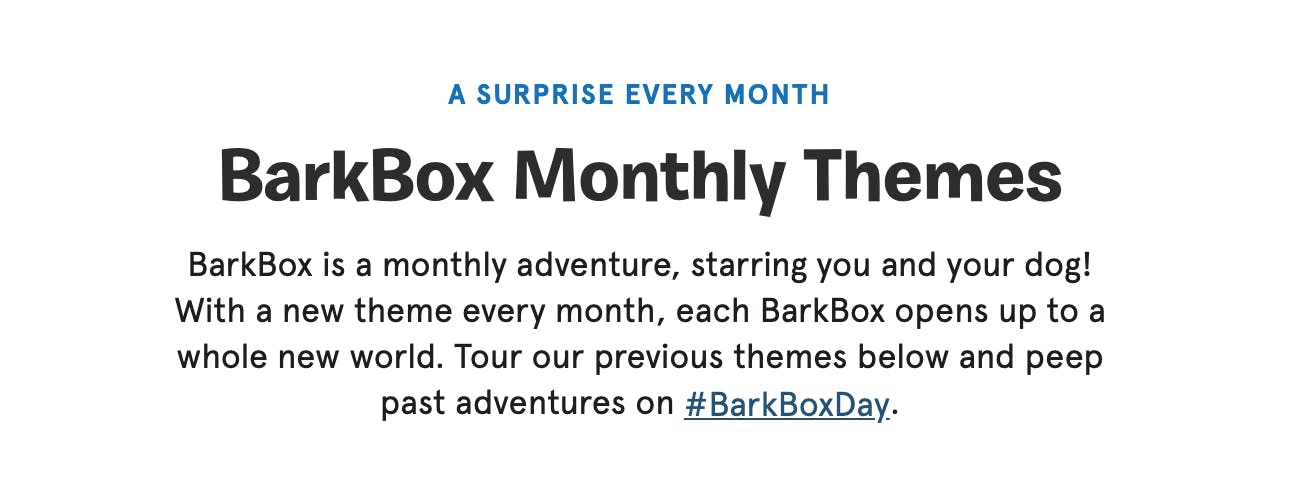
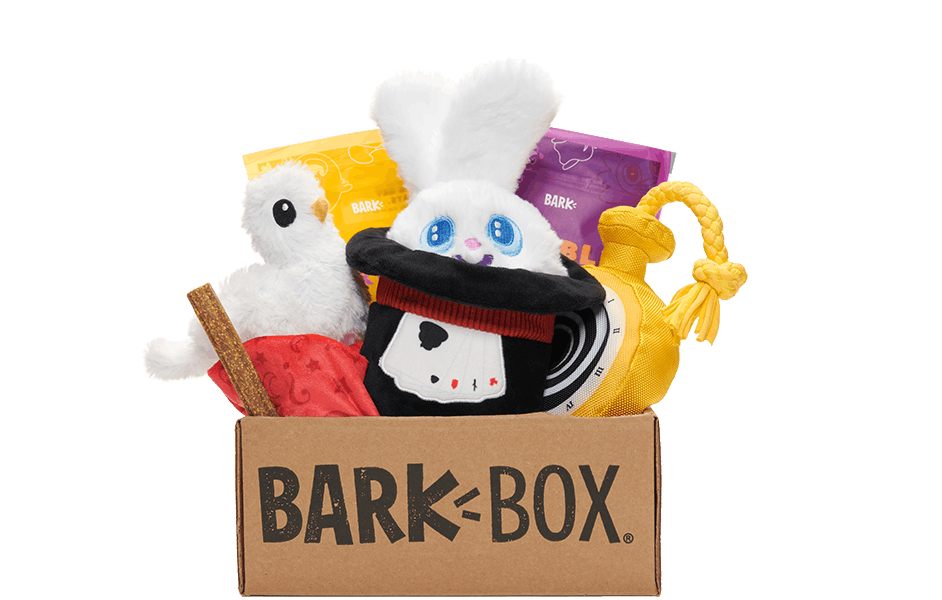
Since the launch in 2012, over two million dogs have received a BarkBox. And those dogs and their parents seem to be happy, as BarkBox has over 600,000 subscribers with a 95% retention rate. It’s valuation is estimated to be between $150 - $200 million. Today, BarkBox has expanded into many new product categories, thousands of retail locations, and continues to grow. BarkBox believes that, generally, the more people are talking about your business, the better. And people are definitely still talking about BarkBox.
A $130-billion market
What we were seeing is a $130 billion market, or at least it's going to be $130 billion in the next couple of years. And that's just for pet products. Which is why there's so many companies that are popping into this. BarkBox, however, has been around for a while. And what we love about BarkBox is that they have stayed true to their mission of these subscription boxes and they've gotten the product right.
I don't know if you've ever been a subscriber, but someone gifted me a number of subscriptions, and it's been fascinating because the dog pretty much works through everything within the month. This is quite possibly one of the best DTC monetization jobs that we have seen in a long time.
BarkBox's pricing page
Customization
One big thing that BarkBox has done that was actually a risk because it's very against conventional thinking, is that they contextualize the purchase and they learn more about the customer upfront in order to personalize outreach, and also to start the customer on the right track.
Here's what I'm talking about:
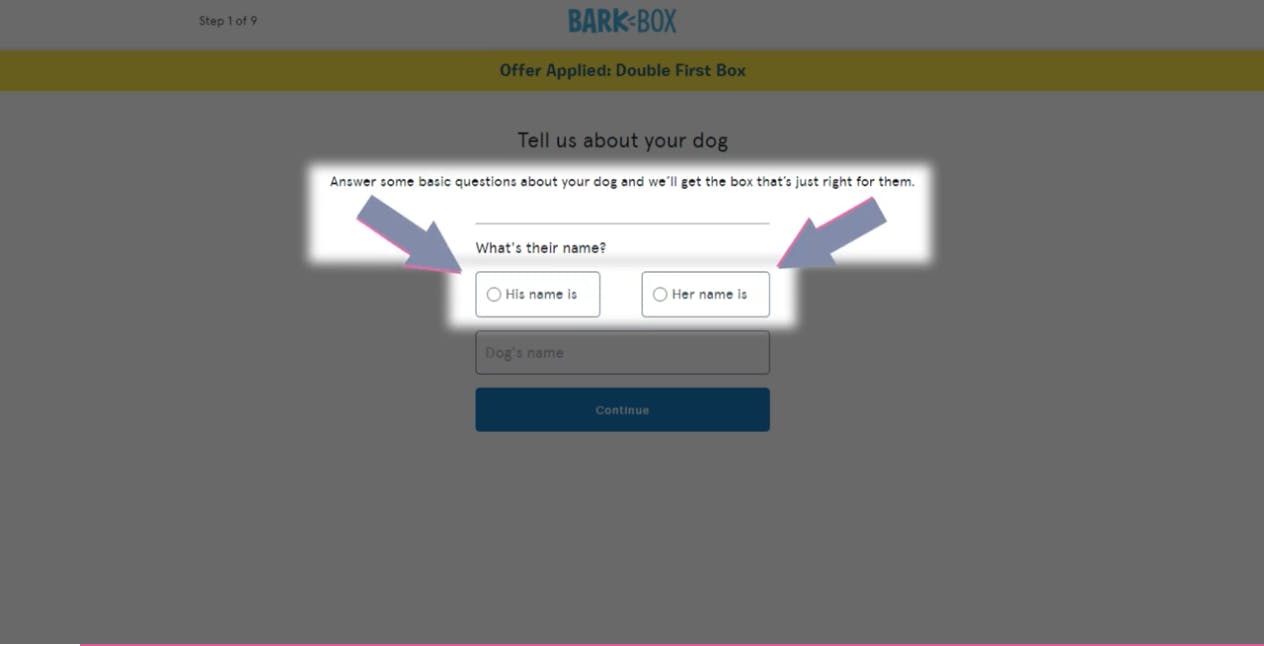
When I go to ”claim offer,” or even sign up, the first thing I go to is what's the dog's name. And I can choose ”his” or “her.” All of a sudden, I know it's a male dog or a female dog and I can put the dog's name in. As I continue through this process, I choose what size it is and they remind me that all boxes are the same price. Which is a really big thing.
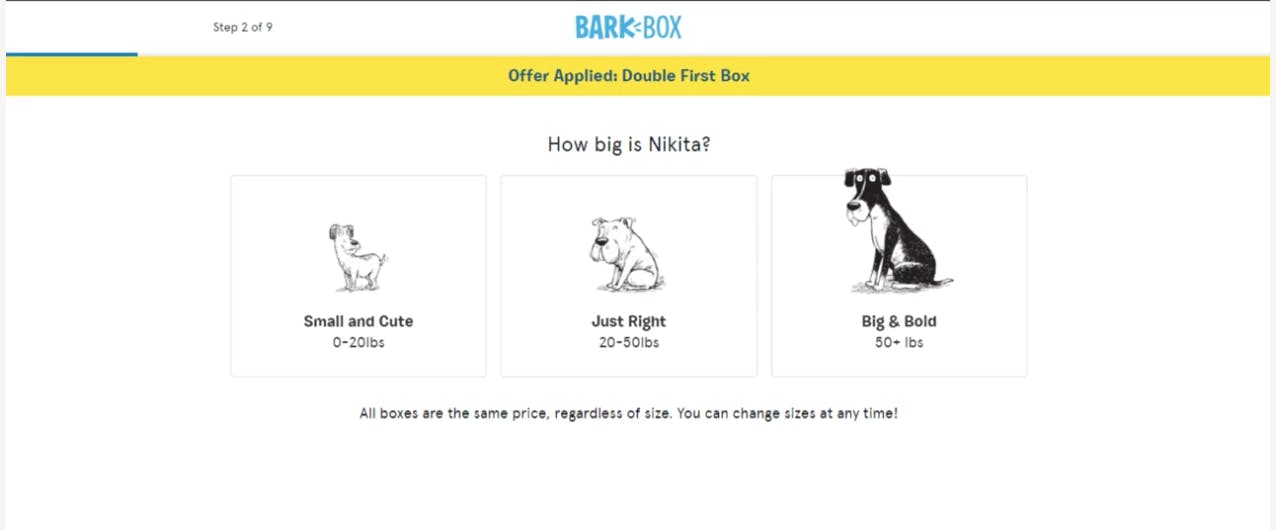
What they're doing here is they're collecting this information in order to understand what they should sell. And you can definitely click out of this, but people are so fanatical about their dogs obviously, that you're able to put things in here in order to understand that customer.
The packages that they end up selling you are then so powerful because they're tailored to you. And when they're tailored to me, I don't want to leave. And if I'm after a purchase, I feel like I accomplished something. I'm not necessarily going to come and fill this date out later.
What it also does, is it gives them data on these different breeds. And so the next time they see a black lab or they see a Shiba Inu, they know exactly what to get it. Because they follow up with customized surveys I'd imagine. They design and have a ton of different toys, treats, and things like that are all their brand. They're putting it together—full stack.
The other thing that's really powerful is they ask for the email address before you can even see the price. I think this is really powerful because let's say I look at the price and I got distracted—I just filled out a bunch of information, but I got distracted. It allows them to nurture me in terms of a lead flow where they can send a, “Hey make sure you order Sloane's box,” whatever it ends up being, in order to make sure that you get those boxes, and ultimately, they come in order for me.
Add-ons in the flow
Another great thing they do is put the add-on right in the flow. You can go through the purchasing process and they actually have this popup that says, “Make Sloan even happier.” “Make your dog even happier,” along with the “yes, please,” or “no, thank you.” What kind of dog owner's gonna click “no, thank you?”
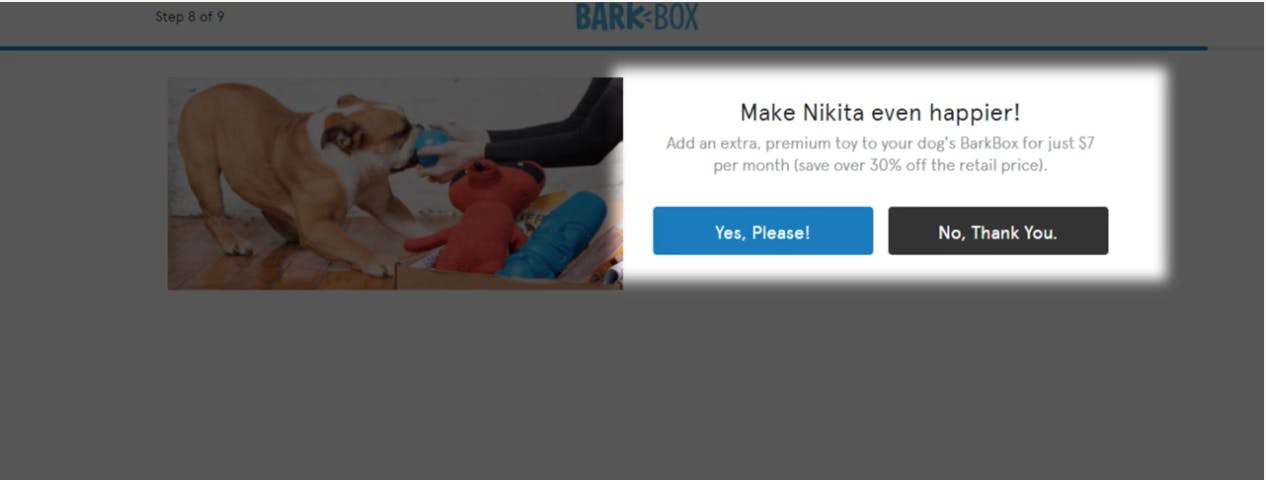
It's an extra $9 per month, which is just under a 30% increase. It increases the price and it's just one of those things that you're like, “Yeah, of course.” Maybe you got a discount, or you’re getting this offer, but you jump in. You can also choose a theme. You can have them surprise you.
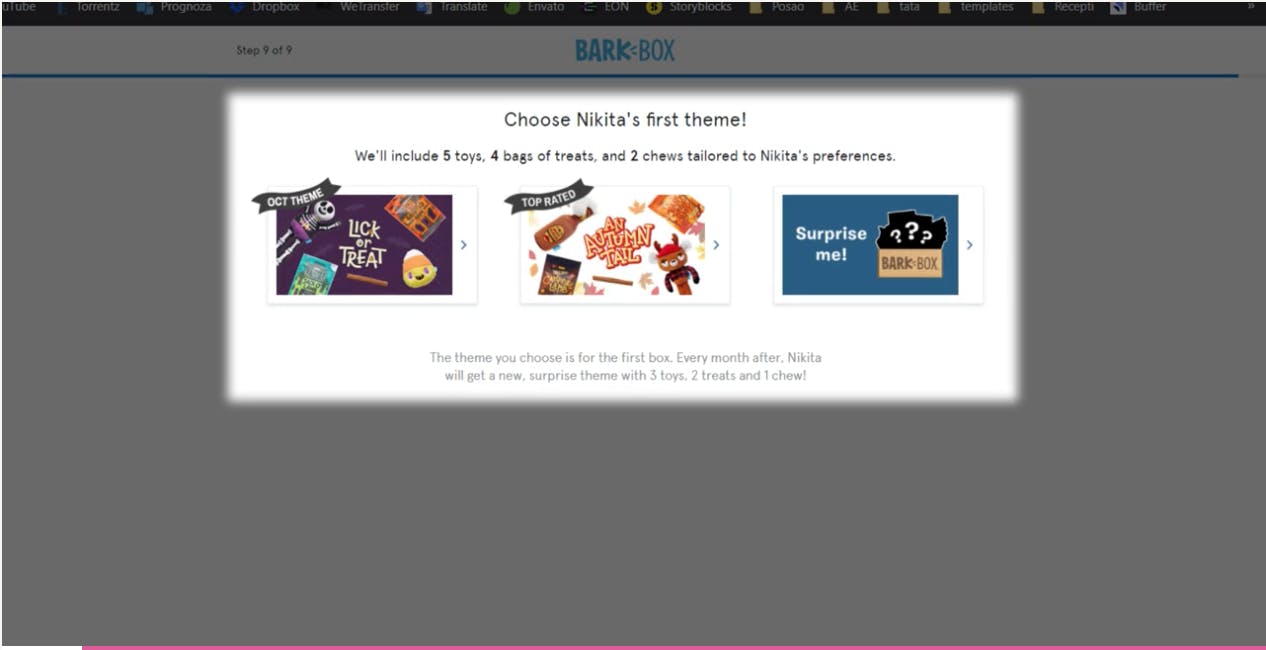
They have figured out the packaging to a tee. And the way they've been able to figure this out and curate these things for dog owners and their customers, is that they collect this information and then they study it in the backend, and they just keep getting better every single month.
Data and analysis
Quarterly, semi-annual, and annual offers help with churn immensely
This is something that we've seen so many DTC companies struggle with. They just don't even do it, which is so sad, but BarkBox is like the slam dunk of this tactic. One of the best examples I've ever seen.
We talk about how a lot of the times companies are listing discount percentages. That doesn't really reconcile with the human brain as well as giving a tangible example of what you're going to get. You see this example on their website. “Free extra toys with a multi-month subscription.” It's perfect. It's exactly what you want. And not everyone's going to take that offer and that's totally fine. But again, we're trying to optimize for those extra months.
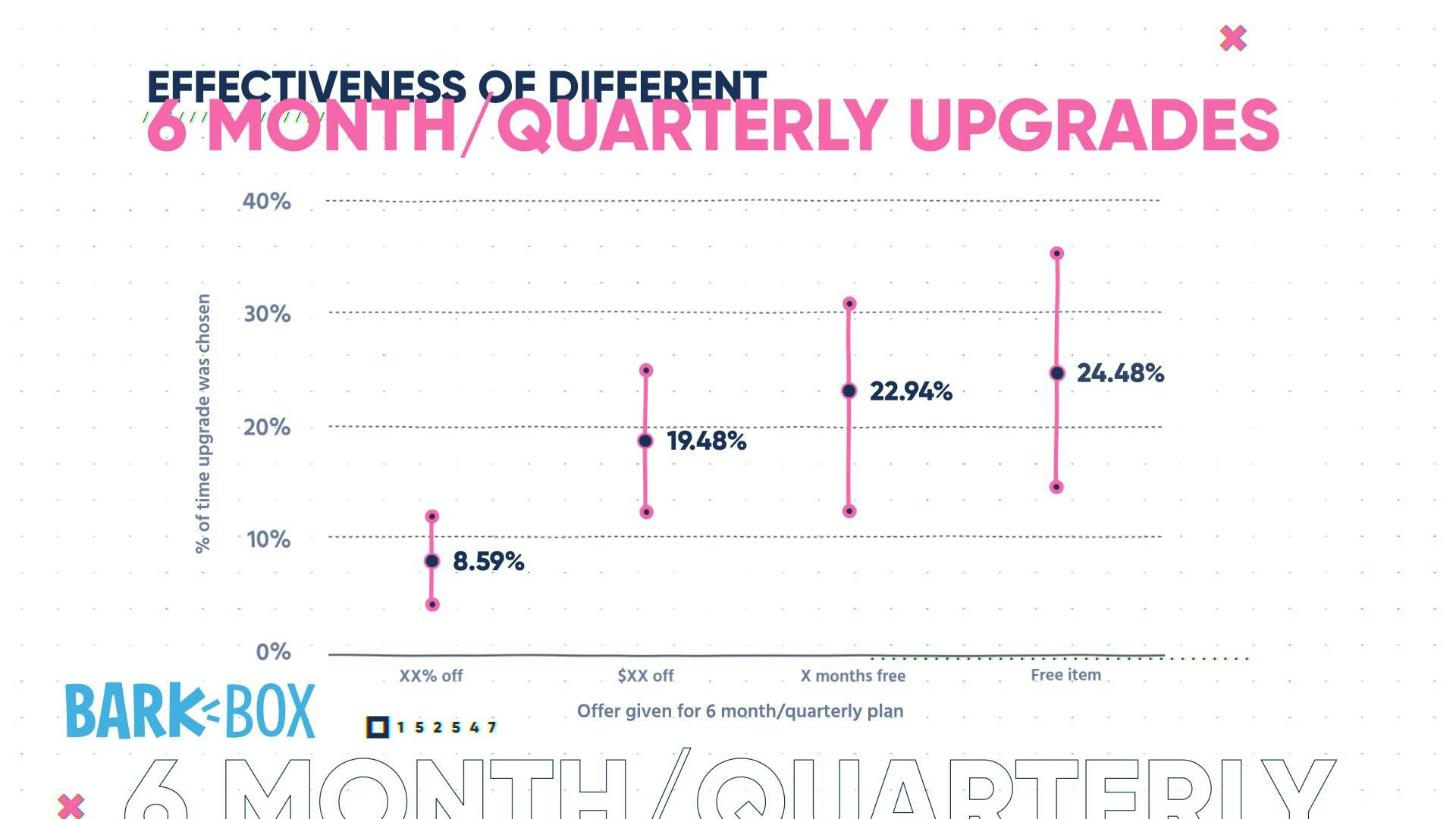
So I think that the minimum you can get is a three-month subscription or a six-month subscription. I think the one thing you have to keep in mind—we've seen this in the data time and time again—when you offer that percentage off, you will get some people to sign up for a multi-month subscription. But if you offer that free item or physical months off, that increases pretty considerably. It's a game changer. A lot of DTC brands have a cost structure where offering dollars off can actually get pretty costly.
Fragmented large markets provide opportunities for differentiation
There are so many things that you spend money on, in this case, unrelated to toys. And one thing that BarkBox has done over the years, is tested different, additional products that they could offer. They had a vet network, some adoption things, among others. But, what they've settled on, at least right now, is they have a couple of different brands that you can see on their website.
One is Super Chewers. This is for dogs that are a little bit more intense—very durable dog stuff. They also have Bright, a dental kit. What Bright has done is make it fairly easy at about a dollar per day. Which, again, there's another $30 per month per subscription that BarkBox, or Bark which is the parent company, is able to optimize.
And just to give some color here, what you should be doing, at least in our opinion, is collecting data in what's called a value matrix.
Value Matrix
You're about to see something called a value matrix. Here, we collected data from the group comparing feature preferences and plotted those on the horizontal axis. More valued features on the right, less valued on the left. We then collected willingness to pay for the overall product and plotted that based on their number one feature preference on the Y axis. Analyzing data in this manner, allows us to determine which features are differentiable. Add-ons, core, or commoditized for each segment.
What you'll notice here is when we tested a bunch of different things like Super Chewers and dental care, they were definitely in this add-on section with a pretty high willingness to pay. Things like cat products—I had to throw that in there just to throw some shade—people just didn't want cat products. We are talking to Bark customers or prospective customers. So, I would think there was probably a little bias there. But even dog food and nutrition was really interesting.
So BarkBox, or Bark, actually has a custom curated dog food line. You can tell them about your dog and they'll put together a plan, and they'll send you food. And they contextualize it a couple different ways. But long story short, they're picking the right spots to expand that average order value, or at least expand their market in the context of this $130 billion market.
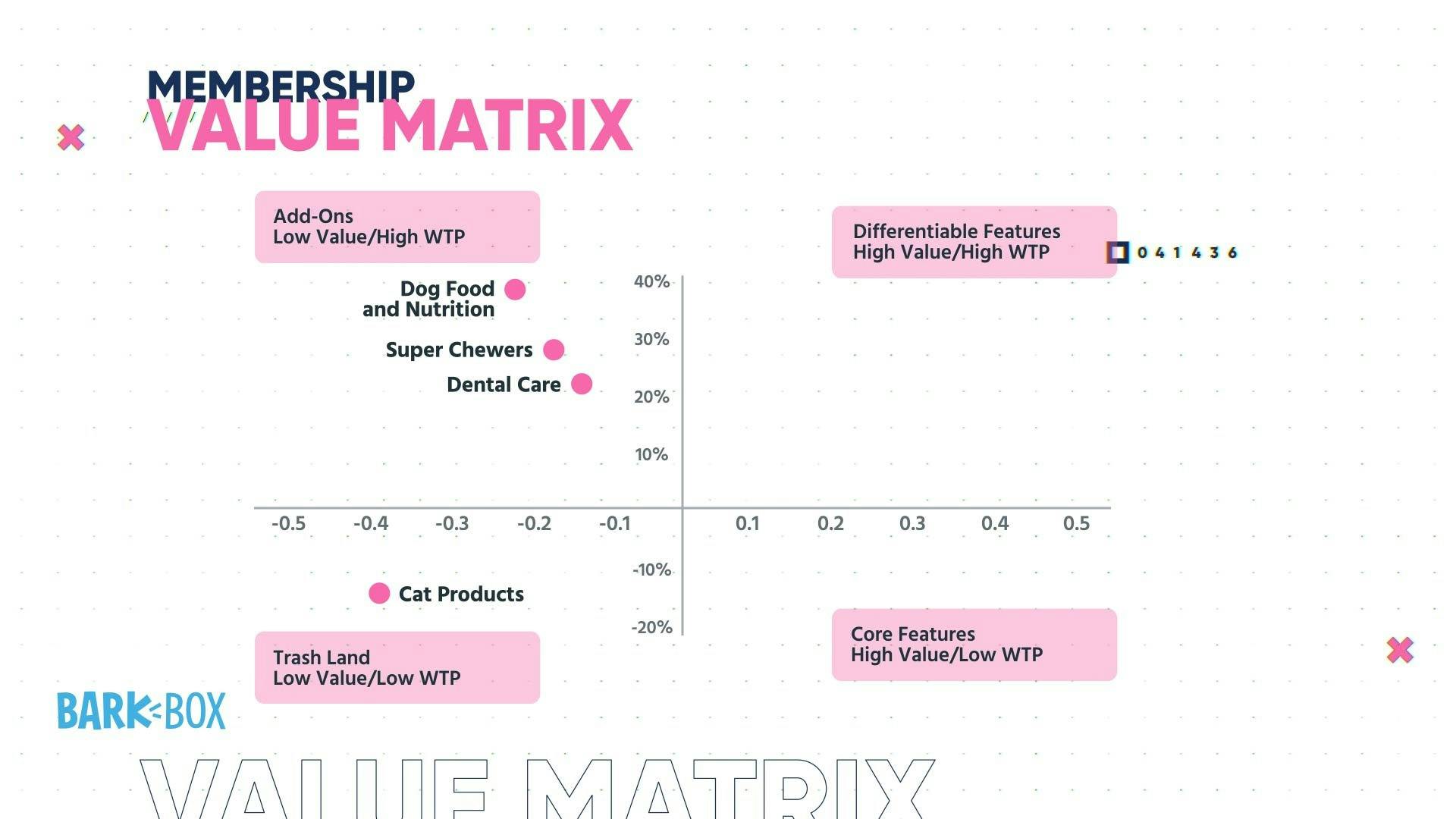
The big takeaway for you and your operations is to make sure that you're understanding what those product lines or those add-ons are that you can expand into. And it could be expanding across the use case—adding additional products, or it could be going deeper on a particular use case to add some premium nature to those particular products in order to fragment across the people who have higher willingness to pay.
I think for folks in the dog industry, people are certainly willing to pay much more for toys and such. But the thing with Bark and BarkBox in particular, is that there's a lot of different folks who don't want to pay more for toys because it's not a child. I want to be a little tempered here, but Bright, the dental care thing, that seems really cool, or the food, I might as well get it from the same brand. And then you're still expanding that average customer value over time.
Localization is absolutely key in such a wide market with consumer products
There are dogs everywhere. Dogs are becoming more and more a member of the family, if you will. Not just in the United States, but elsewhere. Even countries where they traditionally didn't have pets are starting to have dogs as pets. Not necessarily at the level that we are, but in terms of the companionship. And I think that where Bark is kind of missing the mark, at least in the data that we saw, is that there's places in the UK and Western Europe that are more than willing to pay for products like this. But, I think this is the big thing to keep in mind. When you have these markets that are commoditized across the world, you want to start finding ways that you can actually sell into those markets for expansion. And for what it's worth, it is extremely rare that you'll have a company that's doing 300 to 400 million or more in revenue that is not international.
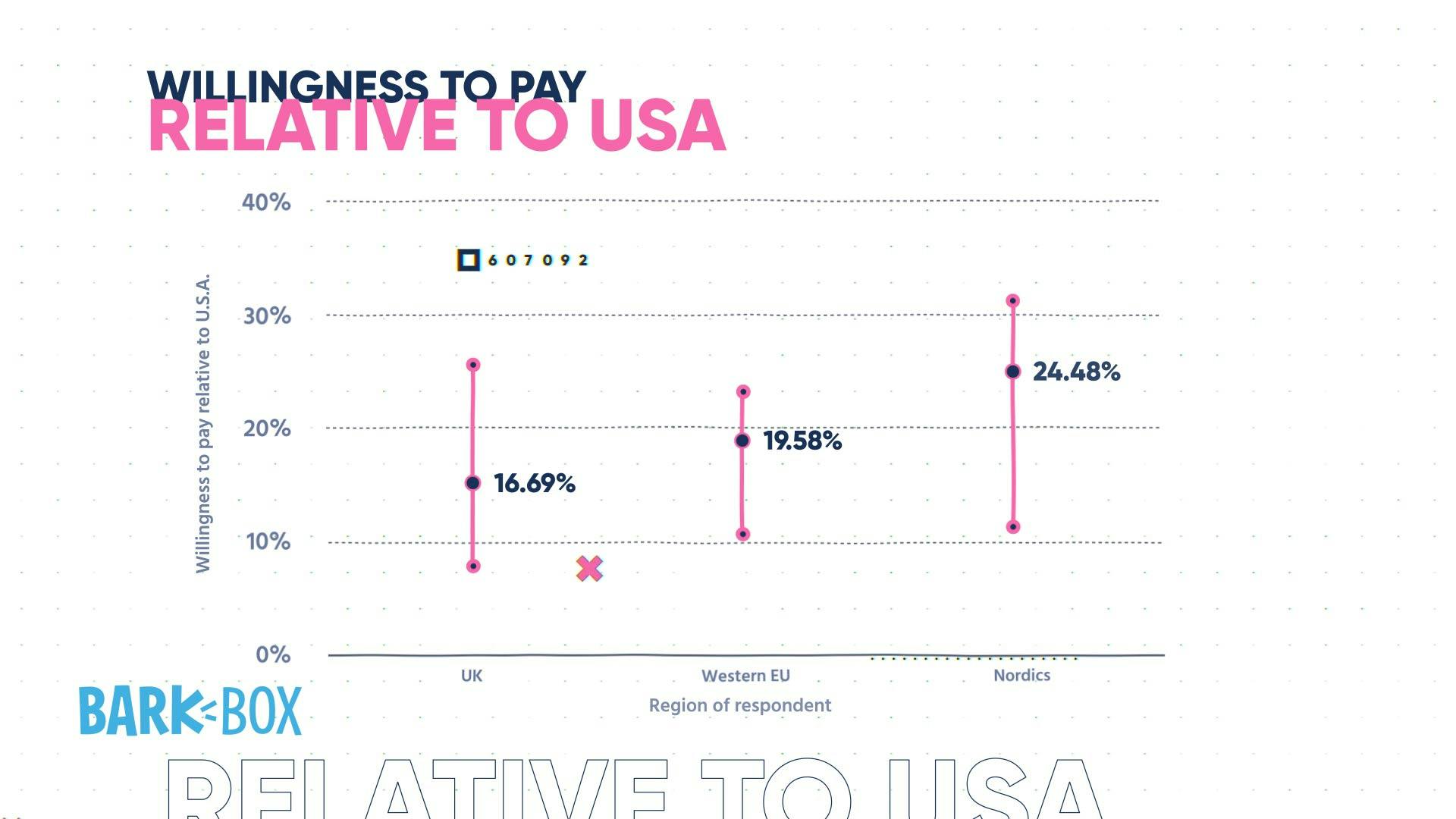
There are companies that do exist, but it makes it much harder. And if you can sell across the world, things get a lot better. We've talked about how there's a level of maturity you need to reach to be able to properly take advantage of globalization. Shipping's the hard thing. I can sell software everywhere, all day, but shipping gets really complicated. I know there's products that make this a lot easier, but I think the big thing to keep in mind is that Bark is big enough to do this. And you should definitely do this before hundreds of millions of dollars in revenue. Once you're reaching that 10-million mark in DTC, it’s a really good expandable growth opportunity that’s worth the pain to figure out what this does.
Let's recap.
- Quarterly, semi-annual, and annual offers help churn immensely. I just love what these guys are doing here. We talk. The offer is so tight. The offer's good. It's so good. Every single company in the DTC space. I mean, there's a few that are usage based that shouldn't be. But, every single company should be copying what Bark does here.
- Fragmented markets provide opportunities for differentiation. You have to understand, if you're in a really wide market, you have to understand what those customers are willing to pay more for. Whether it's a more premium version of a product, or it's an add-on, or additional types of products that are tangential to the core product. This is crucial because you have to get that average order value up. And ultimately, you want to make sure that that customer has higher LTV. Retention, especially for subscriptions, is much higher with those customers who are buying additional products.
- Localization is key in such a wide market with consumer products. Consumers all over the world have different tastes. So the packaging is going to be different. Bark has learned so much and they definitely should be expanding if they're not already. We did check the VPN, but it wasn't really obvious if they were shipping elsewhere. This is something that every DTC brand in the five to 10-million dollar mark, should be considering if you figured out the logistics to go international.
You're not going to go to every country in the world, but you should be going to the countries you think you can actually sell more into, either in terms of volume or of course, into a more premium price. Dogs are everywhere.
